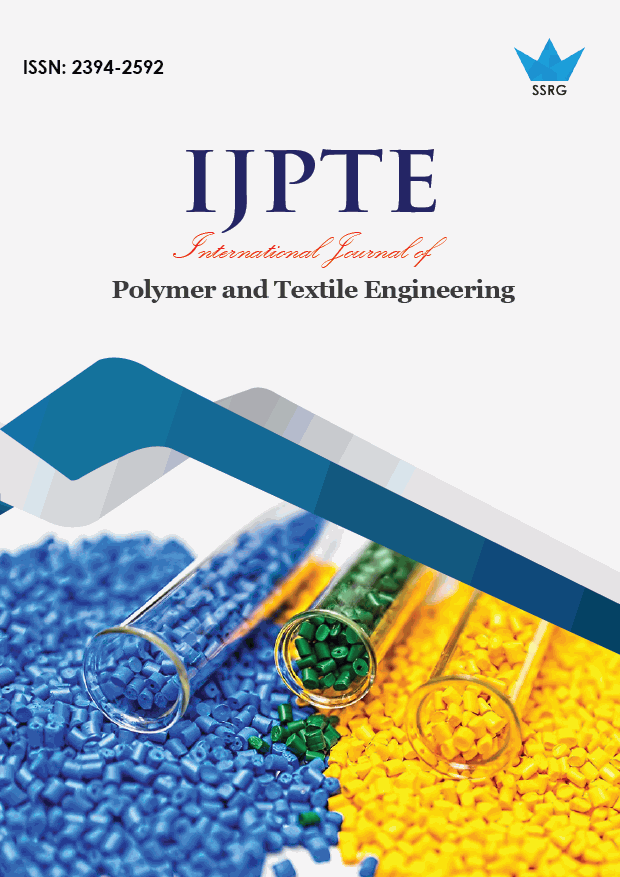Studies on the tensile properties of Banana stalk fibres from Njombe – Penja –Cameroon

| International Journal of Polymer and Textile Engineering |
| © 2020 by SSRG - IJPTE Journal |
| Volume 7 Issue 1 |
| Year of Publication : 2020 |
| Authors : D.Nkemaja Efeze, N.R. SikameTagne, S. Anafack .M, P.W. Huisken, E.MbouT, E. Njeugna. |
How to Cite?
D.Nkemaja Efeze, N.R. SikameTagne, S. Anafack .M, P.W. Huisken, E.MbouT, E. Njeugna., "Studies on the tensile properties of Banana stalk fibres from Njombe – Penja –Cameroon," SSRG International Journal of Polymer and Textile Engineering, vol. 7, no. 1, pp. 68-75, 2020. Crossref, https://doi.org/10.14445/23942592/IJPTE-V7I1P110
Abstract:
This work is aimed at characterizing and comparing the mechanical properties of the unbleached and bleached banana stalk fibres, namely the Cavendish William variety. Banana tree belongs to the Musaceae Family and has a high fibrous potential, particularly in the stalk. In this work, the stalks collected were sectioned into different sections(A, B, C) and zones (Peripheral, Inter media, and Center) located on the longitudinal and cross sectional part respectively. The fibres were extracted through retting process. After extraction, the fibres underwent tensile test using the Universal testing tester. The results obtained in the case of unbleached fibres showed that, elongation vary from 1.63% to 3.06%; breaking force from 1.78 N to 3.45 N; tenacity from 0.11 N / Tex to 0.23 N / Tex; and initial modulus vary from 2210 N / Tex to 4235 N / Tex. The strength of initial modulus increases from the center to the periphery. The results of the tensile properties of bleached fibres are similar to that of unbleached fibres and followed the following trend, elongation vary from 1.76% to 3.61%; breaking force from 1.56 N to 2.61N; the tenacity from 0.13 N / Tex to 0.34 N / Tex and initial Young modulus varies from 2306 N / Tex to 3250 N / Tex and increases from the center to the periphery. It is noted that the elongation of the banana stalk fibreis similar to that offlax and ramie.
Keywords:
Banana stalk Fibres; Retting Tensile properties, Initial Young Modulus.
References:
[1] Ramesh M.,Palanikumar K., Hemachandra Reddy K., Mechanical property evaluation of sisal–jute–glass fiber reinforced polyestercomposites, Journal of Composite Part B Engineering,2013 . 48:1–9.
[2] Fagbemigun T. K., Fagbemi, O. D., Buhari, F., Mgbachiuzo, E., &Igwe, C. C.
Banana peduncle and banana leaf (Musa sapientum)–potential green resources for pulp and paper production. Journal of Scientific Research and Reports, (2016).1-13.
[3] N.R. SikameTagne, E. Njeugna, M. Fogue, J.Y. Drean and D. Fokwa,.Study of Water Diffusion through Raffia Viniferafibres of the Stem from Bandjoun- Cameroon: Case of Drying Kinetics,Industrial Crops & Products,2013, p 3547 -3548.
[4] Njeugna, E., N.R. SikameTagne, J.Y. Drean, D. Fokwa and O. Harzallah, Mechanical characterization of raffia fibres
from raphiavinifera. Int. J. Mech. Structure.,2012. 3(1): 1-17.
[5] Nkemaja Dydimus Efeze, Ndapeu D, Sikame N, Tchemou G, K. Murugesh Babu ,NJEUGNA Ebenezer, Effects of chemicals on the physical and mechanical properties of rhombifolia fibre International Journal of Fiber and Textile Research8(1): 2018 p 1-7
[6] Toledo, M., & González, B. (2018). Banana fiber from Canary Islands: science and extraction. In IX International Scientific Agriculture Symposium” AGROSYM 2018”, Jahorina, Bosnia and Herzegovina, 4-7 October 2018. Book of Proceedings (pp. 457-462). University of East Sarajevo, Faculty of Agriculture.
[7] Morton W. E and Hearle JWS, Physical Properties of Textile Fibres, Textile Institute, Manchester 1993, 3rd edition pp267-269,& pp275,
[8] Chen, H.; Peng, X. (2011). Method for preparing fibers from stalks and leaves of banana through steam explosion-based degumming. Faming Zhuanli Shenqing, CN 101982571 A20110302.
[9] NWAPA, C. , OKUNWAYE, O. J. ,OKONKWO, C. L. CHIMEZIE, O. W. Mechanical Properties of High Density Polyethylene and Linear Low Density Polyethylene Blend April 2020, SSRG International Journal of Polymer and Textile Engineering (SSRG-IJPTE) – Volume 7
[10] Boopalan, M.,M. Niranjanaa, and M. J. Umapathy. “Study on the mechanical properties and thermal properties of jute and banana fiber reinforced epoxy hybrid composites.” Composites Part B: Engineering 51 (2013) 54-57

 10.14445/23942592/IJPTE-V7I1P110
10.14445/23942592/IJPTE-V7I1P110